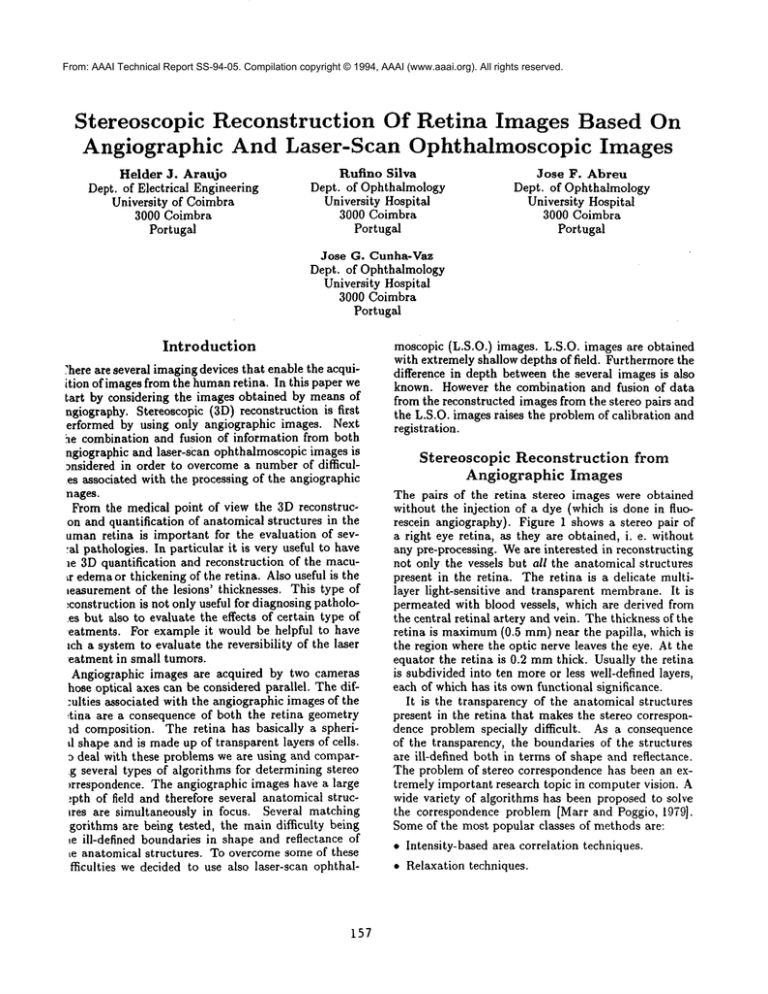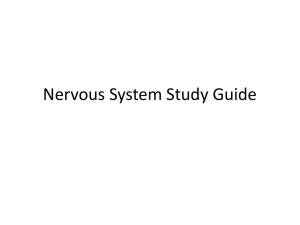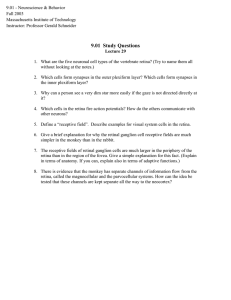
From: AAAI Technical Report SS-94-05. Compilation copyright © 1994, AAAI (www.aaai.org). All rights reserved.
Stereoscopic
Angiographic
Reconstruction
Of Retina Images Based On
And Laser-Scan
Ophthalmoscopic
Images
Helder J. Araujo
Dept. of Electrical Engineering
University of Coimbra
3000 Coimbra
Portugal
Rufino Silva
Dept. of Ophthalmology
University Hospital
3000 Coimbra
Portugal
Jose F. Abreu
Dept. of Ophthalmology
University Hospital
3000 Coimbra
Portugal
Jose G. CunhaoVaz
Dept. of Ophthalmology
University Hospital
3000 Coimbra
Portugal
Introduction
?here are several imagingdevices that enable the acquiition of images from the humanretina. In this paper we
tart by considering the images obtained by means of
ngiography. Stereoscopic (3D) reconstruction is first
erformed by using only angiographic images. Next
he combination and fusion of information from both
ngiographic and laser-scan ophthalmoscopic images is
)nsidered in order to overcome a number of difficules associated with the processing of the angiographic
nages.
From the medical point of view the 3D reconstrucon and quantification of anatomical structures in the
umanretina is important for the evaluation of sev:al pathologies. In particular it is very useful to have
le 3D quantification and reconstruction of the macu~r edemaor thickening of the retina. Also useful is the
masurementof the lesions’ thicknesses. This type of
:construction is not only useful for diagnosing patholoes but also to evaluate the effects of certain type of
eatments. For example it would be helpful to have
mha system to evaluate the reversibility of the laser
eatment in small tumors.
Angiographic images are acquired by two cameras
hose optical axes can be considered parallel. The dif:ulties associated with the angiographic images of the
,tina are a consequence of both the retina geometry
ld composition. The retina has basically a spherid shape and is madeup of transparent layers of cells.
deal with these problems we are using and comparg several types of algorithms for determining stereo
)rrespondence. The angiographic images have a large
.~pth of field and therefore several anatomical strucires are simultaneously in focus. Several matching
gorithms are being tested, the main diff~culty being
le ill-defined boundaries in shape and reflectance of
te anatomical structures. To overcome some of these
¯ culties we decided to use also laser-scan ophthal-
157
moscopic (L.S.O.) images. L.S.O. images are obtained
with extremely shallow depths of field. Furthermore the
difference in depth between the several images is also
known. However the combination and fusion of data
from the reconstructed images from the stereo pairs and
the L.S.O. images raises the problem of calibration and
registration.
Stereoscopic
Reconstruction
from
Angiographic
Images
The pairs of the retina stereo images were obtained
without the injection of a dye (which is done in fluorescein angiography). Figure 1 shows a stereo pair of
a right eye retina, as they are obtained, i. e. without
any pre-processing. Weare interested in reconstructing
not only the vessels but all the anatomical structures
present in the retina. The retina is a delicate multilayer light-sensitive
and transparent membrane.It is
permeated with blood vessels, which are derived from
the central retinal artery and vein. The thickness of the
retina is maximum(0.5 mm)near the papilla, which
the region where the optic nerve leaves the eye. At the
equator the retina is 0.2 mmthick. Usually the retina
is subdivided into ten more or less well-defined layers,
each of which has its ownfunctional significance.
It is the transparency of the anatomical structures
present in the retina that makes the stereo correspondence problem specially difficult.
As a consequence
of the transparency, the boundaries of the structures
are ill-defined both in terms of shape and reflectance.
The problem of stereo correspondence has been an extremely important research topic in computer vision. A
wide variety of algorithms has been proposed to solve
the correspondence problem [Marr and Poggio, 1979].
Someof the most popular classes of methods are:
* Intensity-based area correlation techniques.
* Relaxation techniques.
stereo correspondence is considered a special case of a
data association problem, in which we try to associate
the measurements, i. e. the images, obtained by the
two cameras. Let s = 1, 2 denote the two cameras.
Suppose that the number of measurements of sensor 8
is n,. These measurements represent the pixels’ graylevel values obtained by each camera along corresponding epipolar lines. Assumethat there are T 3D points
(T unknown) on the epipolar plane. Each camera
measures only a gray-level value gsj of each of the potential 3D points j. The noisy scalar measurementz,,i
is given by
z,.,
Figure 1: Left and right images of a right retina
¯ Dynamic programming [Ohta and Kanade, 1985].
¯ Prediction and verification techniques.
These classes of methods can also be classified into
intensity-based or feature-based algorithms according
to the type of primitives they use in trying to find correspondences. Many of the feature-based stereo algorithms use edges as primitives. These matching primitives should be specific, so that corresponding points
may be accurately localized,and they should be stable
under photometric and geometric distortions caused by
the difference in viewing position. In the case of the
retina images the anatomical structures have ill-defined
boundaries in shape and reflectance and exhibit nonstep edge profiles. For these reasons we decided not
to use edge-based stereo algorithms. Wehave already
tested several intensity-based algorithms. One of them
was the algorithm described in [Kim et al., 1990]. This
algorithm establishes correspondences between points
by examining whether two points have similar intensity
gradients within a small neighborhood around those
two points. Even though the global performance of the
algorithm was satisfactory, its computational cost prevents its practical use in a medical application. Due
to the particular nature of our images we decided to
test and use an algorithm based on the one described
in [Coxet al., 1992].
The Stereo Correspondence Algorithm
The central assumption of this stereo matching algorithm is that corresponding pixels in the left and right
images have gray level values that are normally distributed about a commonvalue. The problem of establishing correspondence is then formulated as one of
optimizing a Bayesian maximumlikelihood cost function. The problem of stereo matching is considered as
a special case of a sensor fusion problem. The cost
function used is based on the approach proposed by
[Pattipati et al., 1990] for multisensor data association.
Within the framework of this approach the problem of
158
= (1 - + ",,d
+
(1)
where a,,i is a binary random variable such that
as,i - 0 when the measurement is from a true 3D point,
and a,,i = 1 if it is a spurious measurement.The statistical errors associated with the measurementsof a true
3D point vs,i are assumed to be N(0, #7)" The measurement noises are assumed to be independent across
cameras. The density of spurious measurements w,,i
is assumed to be uniform. Let Z, represent the set
of measurements obtained by each camera along corresponding epipolar lines. Let also Pp. denote the detection probability of camera s. To account for the incomplete pixel-3D point associations caused by missed
detections, a dummymeasurement z,,0 is added to each
of the measurements of camera s. The matching to zs,0
indicates no corresponding point. The set of measurements from camera s (including the dummymeasurement z,.0) is denoted by Z, = {z,.i,}~’=0 where n, is the
number of measurements from camera 8. For epipolar
alignment of the scanlines, Zs is the set of measurements along a scanline of camera 8. These measurements z,,i, are the gray-level intensity values. Each
measurement z,,i, is assumed to be corrupted by additive white noise.
The condition that intensity value zl,i, from camera
1, and measurement z2,i~ from camera 2 originate from
the same location zv in space, i. e. that zl,il and z2.h
correspond to each other is denoted by Zi~,i~. That is
Zil,i~ is a 2-tuple of measurements. For example, Zi~,0
denotes occlusion of feature zl,i, in camera 2.
The likelihood function of this 2-tuple being the set
of gray-level values that originated from the same 3D
point is the mixed probability density function:
I p) =
[Po,v(z,,.
¯ [Po.v(z2,.
I
[1- Po,]’0’,¯
’°’’
- Po.]
where 50,i, is the Kronecker function defined by
50,i,
is detection,
not assigned
[ 1 if i.e.
i, =a0measurement
denoting a that
missed
a corresponding point (it is occluded)
/
0 otherwise
?herefore
function
A(Zi,,i2 ]zp) denotes
thelikelihood
hat the measurement
pairZit,i~orginated
fromthe
ame3D pointzp andalsorepresents
thelocMcostof
hatching
twopointszl,itandz~,i~.The termp(z
’p)is a probability
density
distribution
thatrepresents
he likelihood
of measurement
z, assuming
it originated
:orea pointxp - (z,y, z) in thescene.
Theparameter
’0.,asalready
mentioned,
represents
theprobability
of
etecting
a measurement
originating
fromxp at sensor
Thisparameter
is a function
of the noise,number
f occlusions,
etc.It is assumed
thatthemeasurement
ectorsz,j,arenormally
distributed
abouttheirideal
aluez. Onceestablished
thecostof theindividual
airings
Zi~,i~,
itis necessary
todetermine
thecostof
II pairs.
Denote
by
7 = {{Zi,,i,,il
= O, 1,...,nl;i~
Figure 2: Image with disparities
= O, 1,...,n2},Zl}
a feasible pairing of the set Z into measurement-3D
oint associations (2-tuples) Zq ,i, except the case when
[1 i, = 0. The set Z! contains the measurements from
II sensors deemedspurious, that is, not associated with
ay3D pointinthepairing
7.Denote
thesetofallfeable partitions
as r = {7}.We wishto findthethe
tostlikely
pairings
orpartitions
7 of themeasurement
:t Z. Themostlikelypairings
areobtained
by maxitiring,
overthesetofallfeasible
partitions,
theratio
thejointlikelihood
function
of allthemeasurements
the likelihood
function
whenallthe measurements
:edeclared
false.
Letusdenote
thelatter
partition
as
~. Then7o denotesthecasewhereall measurements
,e unmatched,
i.e.thecaseinwhichthereareno corsponding
points
in theleftandrightimages.
Thatis,
e wantto determine
L(7)
~r L(70)
max
here the likelihood L(7) of a pairing is defined
L(7)= p(Z, Z217)
l’I
(3)
Z,i,iaE7
where¢, is the field of view of camera s and ms is
e number of unmatched measurements from camera
in partition 7. Basically we assume that the density
the spurious measurements is uniform and is given
, l/~b,. The likelihood of no matches L(7) is given
:70) = 1/(~b~¢M), where Y and Mare the total num.r of points in the left and right images respectively.
he maximization of the ratio of likelihood functions
performed using a dynamic programming algorithm
bject to uniqueness and ordering constraints. These
nstraints imply the following assumptions:
a feature in the left image can match to no more
than one feature in the right image and vice-versa
(uniqueness).
159
coded as gray levels
¯ if zi,is matched to zi2 then the subsequent image
point zi,+, may only match points zi2+j for which
j>0.
The result from the application of this algorithm to
the images of Figure 1 is displayed in the image of Figure 2. This results was obtained with the following
parameter values: PD, = PD~= 0.99, o" = 2.0 and a
maximum
disparity of 25 pixels. In this image the disparities are coded as gray levels. Black (gray-level 0)
corresponds to occlusion.
Reconstruction
from Laser-Scan
Ophthalmoscopic
Images
and Stereo
L.S.O. images are obtained with extremely shallow
depths of field (in the case of the equipment we are
using the depth of field is less than 0.1 pro). One of
these images is displayed in Figure 3. Our equipment
permits the acquisition of a sequence of nine images
spaced 150/~m apart. Wedo not know the exact depth
at which each image is acquired but we do know their
relative depth ordering. Due to the thickness of the
retina not all of the nine images are useful. Usually
only 4 or 5 of them are images of the retina; the remaining are images of the vitreous body. Due to the
nature of these images some of the retina structures are
in focus in no more than one or two images of the sequence. Other structures, like the papilla maybe visible
in several images but with slightly different sizes. To 3D
reconstruct the retina we propose to combine this sequence of images with the stereo reconstructed image.
The stereo reconstructed image is obtained from the
computeddisparities, using the results from the camera
calibration. For that purpose we are currently using a
procedure [Batista et al., 1986] that improves on Tsai’s
method [Tsai, 1987], adequately adapted to the ophthalmoscope we are using. By using the L.S.O. images
we aim at reconstructing the retina with higher accuracy than it would be possible by using only the stereo
images. Furthermore it is also possible, by combining
Conclusions
In this paper we describedwork currentlyunder
progress
thataimsat the3D reconstruction
of human
retinas.
Twomodalities
of imagesareemployed:
anglographicand laser-scan
ophthalmoscopic.
The specific
nature
of theimages
raises
a number
of difficulties
becauseof thealmostnon-existent
sharpboundaries.
We
showthatsomeof thesedifficulties
canbe overcome
by
usingalgorithms
thatdo notmakeexplicit
useof edges
or othergeometrical
features.
Acknowledgements
Theauthors
wouldliketo thankJNICTforitsfinancial
supportthroughProjectPBIC/C/SAU/1576/92
Figure 3: Laser-scan ophthalmoscopic image
References
bothtypesof images,
to detectandcharacterize
small
abnormalities
of theanatomical
structures
thatarenot
completely
visible
in justoneof thesetypesof images.
To combine
bothtypesof images
theproblem
of registration
hastobe solved.
Therefore
calibration
of L.S.O.
imagesis alsoperformed.
Currently
we areusinga simpleandheuristic
procedure
thatcombines
a calibration
witha knownpatternwitha calibration
basedon the
knowledge
of thephysical
dimensions
of theanatomical
structures.
Thelatter
typeof calibration
is performed
by usingretinaimagesof a healthy
individual
(where
itis expected
thattheanatomical
structures
havestandarddimensions).
As the L.S.O.imagesare acquired
withmuchhigheraccuracythanthe angiographic
imageswe use theformerto correct
andimprovetheangiographic
basedstereoreconstruction.
Consequently
anatomical
structures
haveto be matched
in bothtypes
of images.
Forthatpurpose
theL.S.O.imagesareconsideredto makeup a "stack"and a focusmeasuring
operator
isapplied
toalltheimages
[Diaset al.,1991].
The focusmeasuring
operator
we areusingis basedon
the computation
of the imagegradient.
Thisoperatoris applied
in alltheimagesof thesequence.
Next
eachimageof thesequence
is divided
intosmaller
regionsor windowswhichare analyzedby considering
eachregionin all theimages.Thisway it is possibleto determine,
foreachregion,
theimageof thesequencewherethatregionis moreon focus(we try to
a maximumin the responseof the operator
measuring
the sharpness
of focus).Matchingcan thenbe performedbasedon domain-specific
knowledge.
It is extremely
difficult
andcomplex
to implement
a fullyautomated
matching
procedure,
dueto thespecific
nature
of theseimages.Forthe momentwe proposeto implementan operator-assisted
matching
procedure.
After
theanatomical
structures
havingbeenlocated
in an imageof theL.S.O.
sequence
(byusinga sharpness
offocus
measure)
theoperator
willlocatethesamestructures
in the stereoimage.Basedon the depthinformation
fromthe L.S.O.imagesthe stereoimagecan thenbe
recomputed
so thata moreaccurate
3D rdconstruction
of theretina
canbe obtained.
160
[Batista et al., 1986] J. Batista, J. Dias, H. Araujo, and
A. T. Almeida. Monoplane Camera Calibration:
An
Iterative Multistep Approach. In J. Illingworth, editor, British Machine Vision Conference I993, pages
479-488. BMVA,May 1986.
[Cox et al., 1992] I.J. Cox, S. Hingorani, B.M. Maggs,
and S.B. Rao. Stereo Without Regularization. Internal NECReport, October 1992.
[Dias et al., 1991] J. Dias, A. Almeida, and H. Araujo.
Depth Recovery Using Active Focus In Robotics.
In International Workshop on Intelligent Robots and
Systems 1991, pages 249-255, 1991.
[Kim et al., 1990] N. H. Kim, A.C. Bovik, and S.J. Aggarwal. Shape Description of Biological Objects via
Stereo Light Microscopy. IEEE Trans. on Systems,
Man and Cybernetics, 20(2):475-489, March/April
1990.
[Mart and Poggio, 1979] D. Marr and T. Poggio. A
Computational Theory of HumanStereo Vision. Proceedings of the Royal Society of London, 204(Series
B):301-328, 1979.
[Ohta and Kanade, 1985] Y. Ohta and T. Kanade.
Stereo by Intra- and Inter-Scanline Search Using Dynamic Programming. IEEE Trans. on Patt. Analysis
and Man. Intelligence,
PAMI-7(2):139-154, March
1985.
[Pattipati et al., 1990] K.R. Pattipati, S. Deb, Y. BarShalom, and R. B. Wasburn. Passive Multisensor Data Association Using A New Relaxation Algorithm. In Y. Bar-Shalom, editor, MultitargetMultisensor Tracking: Advanced Applications, pages
219-246. Artech House, 1990.
[Tsai, 1987] R. Tsai. A Versatile Camera Calibration Technique For High-Accuracy 3d Machine Vision Metrology Using Off-the-Shelf TV Cameras And
Lenses. IEEE Journal of Robotics and Automation,
RA-3(4), August 1987.







